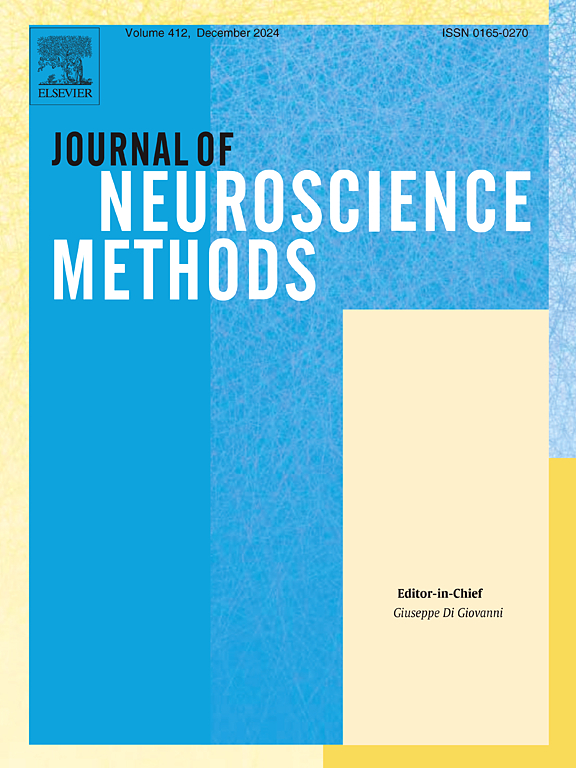再生电极界面免疫标记纤维定量空间分析方法
IF 2.7
4区 医学
Q2 BIOCHEMICAL RESEARCH METHODS
引用次数: 0
摘要
背景:人们正在探索将再生电极作为神经假体控制和感觉反馈的强大外周神经接口。目前的设计在电极数量、空间布局和孔隙率方面存在差异,这影响了装置接口处纤维的再生、激活和空间分布。了解感觉和运动纤维的分布对于优化选择性纤维激活和记录非常重要:新方法:我们使用免疫荧光和共聚焦显微镜观察和分割整个神经,对再生电极界面上的免疫标记纤维进行空间分析:结果:采用这种方法分析了3条大筛电极再生(MSE)、3条硅胶导管再生和3条未操控的对照啮齿动物坐骨神经的运动纤维分布特征。对照组、MSE 和导管神经的运动纤维总数分别为 1485 [SD: +/- 50.11]、1899 [SD: +/- 359] 和 5732 [SD: +/- 1410]。MSE 运动纤维分布显示出偏离完全空间随机性的证据,以及在不同尺度上的分散和集群趋势的证据。值得注意的是,MSE 运动纤维在横截面中央部分表现出集群,而导管再生运动纤维则沿外围表现出集群:与现有方法的比较:之前对再生界面纤维分布的研究仅限于对随机取样的子区域进行象限密度分析或定性描述。这种方法扩展了现有的样本制备和显微镜技术,可定量评估整个神经横截面内的免疫标记纤维分布:结论:该方法是检查再生电极界面免疫标记纤维亚群空间排列的有效方法,可对相对于电极排列的纤维分布进行稳健评估。本文章由计算机程序翻译,如有差异,请以英文原文为准。
A method for quantitative spatial analysis of immunolabeled fibers at regenerative electrode interfaces
Background
Regenerative electrodes are being explored as robust peripheral nerve interfaces for neuro-prosthetic control and sensory feedback. Current designs differ in electrode number, spatial arrangement, and porosity which impacts the regeneration, activation, and spatial distribution of fibers at the device interface. Knowledge of sensory and motor fiber distributions are important in optimizing selective fiber activation and recording.
New Method
We use confocal microscopy and immunofluorescence methods to conduct spatial analysis of immunolabeled fibers across whole nerve cross sections.
Results
This protocol was implemented to characterize motor fiber distribution within 3 macro-sieve electrode regenerated (MSE), 3 silicone-conduit regenerated, and 3 unmanipulated control rodent sciatic nerves. Total motor fiber counts were 1485 [SD: +/- 50.11], 1899 [SD: +/- 359], and 5732 [SD: +/- 1410] for control, MSE, and conduit nerves respectively. MSE motor fiber distributions exhibited evidence of deviation from complete spatial randomness and evidence of dispersion and clustering tendencies at varying scales. Notably, MSE motor fibers exhibited clustering within the central portion of the cross section, whereas conduit regenerated motor fibers exhibited clustering along the periphery.
Comparison with Existing Methods
Prior exploration of fiber distributions at regenerative interfaces was limited to either quadrant-based density analysis of randomly sampled subregions or qualitative description. This method extends existing sample preparation and microscopy techniques to quantitatively assess immunolabeled fiber distributions within whole nerve cross-sections.
Conclusions
This approach is an effective way to examine the spatial organization of fiber subsets at regenerative electrode interfaces, enabling robust assessment of fiber distributions relative to electrode arrangement.
求助全文
通过发布文献求助,成功后即可免费获取论文全文。
去求助
来源期刊

Journal of Neuroscience Methods
医学-神经科学
CiteScore
7.10
自引率
3.30%
发文量
226
审稿时长
52 days
期刊介绍:
The Journal of Neuroscience Methods publishes papers that describe new methods that are specifically for neuroscience research conducted in invertebrates, vertebrates or in man. Major methodological improvements or important refinements of established neuroscience methods are also considered for publication. The Journal''s Scope includes all aspects of contemporary neuroscience research, including anatomical, behavioural, biochemical, cellular, computational, molecular, invasive and non-invasive imaging, optogenetic, and physiological research investigations.
 求助内容:
求助内容: 应助结果提醒方式:
应助结果提醒方式:


